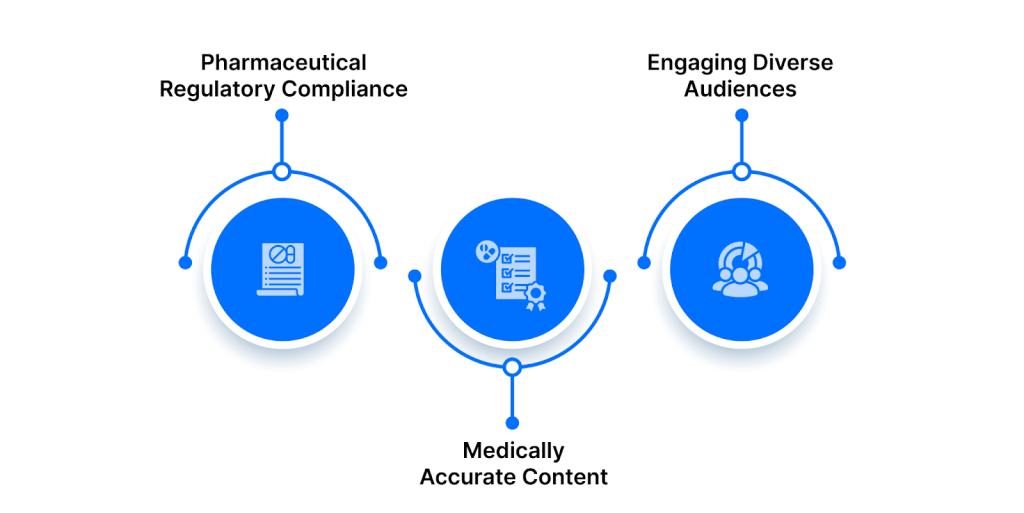🔍
Why Your Pharma Company Needs SEO
Pharma Company SEO is essential for building online trust, attracting the right audience, and staying competitive in a regulated market. Without it, even the best products risk being invisible to doctors, patients, and decision-makers.
Written byChitranshu Sharma
August 26, 2025
Quick Nav
The pharmaceutical industry is crowded. Every year, new biotech firms, generics, and wellness platforms enter the market. Meanwhile, patients, caregivers, and doctors start their journey with a search engine. If your company isn’t visible in those searches, you lose mindshare and revenue.
Let’s walk through why SEO isn’t optional anymore for pharma — and how it works in practice.
How People Now Search for Healthcare
Think about your own habits. When a symptom shows up, you don’t rush to the clinic first. You pull out your phone. You type,“best treatment for seasonal allergies”or“is [drug name] safe long term?”
Patients then compare brands, read reviews, and explore alternatives. By the time they talk to a doctor, they’ve already formed a view. If your company isn’t in that discovery process, you lose influence.
Doctors rely on search too. They check trial data, compare therapies, and scan for regulatory updates. If your content doesn’t appear, they’re learning from someone else.
SEO Builds Authority and Trust
Visibility signals credibility. In healthcare, credibility is everything. Patients won’t trust a drug from a brand they can’t find. Physicians won’t recommend a therapy if official information is buried three pages deep.
For instance, if your trial summary appears on page one, you immediately look more reliable. If it’s hidden on page three, people assume you’re less established.
There’s also compliance to consider. Pharma can’t always promote products directly, but SEO gives you a way to share educational, balanced content that answers questions without crossing regulatory lines. Value-first content earns trust — and avoids penalties.
Competing in a Crowded Market
Your competitors already use SEO. Global players like Pfizer and Roche invest in content hubs, trial libraries, and disease awareness portals. Smaller generics firms publish FAQs and capture long-tail searches like“affordable alternative to [brand drug].”
Meanwhile, online pharmacies and telehealth providers produce blogs and videos that pull patients in. If you don’t claim your space, others control the narrative.
That doesn’t mean you need their budget. You can target niches: a therapy area, a region, or a single condition. Win visibility in those, and you carve out market share.
SEO Goes Beyond Patients
It’s easy to assume SEO is just patient marketing. In reality, your audience is broader:
- Doctors checking guidelines.
- Caregivers comparing treatment options.
- Hospitals evaluating suppliers.
- Regulators verifying data.
- Investors tracking your pipeline.
Each of these groups starts with Google. Each expects accurate, official information. If you design SEO around these segments, your brand becomes visible at every point in the healthcare chain.
Working Within Compliance
Pharma teams often worry:“But regulations stop us from promoting products directly.”That’s correct — and that’s why SEO fits so well.
Instead of pushing a drug, you publish resources on managing a disease, or lifestyle guides that point to broader care options. Within that context, you can responsibly mention your therapy.
Publishing searchable trial data, safety updates, or structured FAQs also reassures regulators and strengthens transparency. Done properly, SEO helps you speak clearly while staying compliant.
Another advantage: you prevent misinformation. Without your content, third-party blogs or forums fill the gap. Some will be outdated, some inaccurate. SEO ensures the right version of your story is easy to find.

Building Awareness for Your Pipeline
Pharma is about more than today’s sales. Future therapies in the pipeline need visibility too. Investors, researchers, and physicians want early updates.
Too often, companies bury this content in hard-to-find press releases. Search-friendly formats — pipeline trackers, research explainers, therapy timelines — give your work visibility months or years before approval.
That way, when a drug is cleared, the market already knows you, instead of meeting you for the first time.
B2B Visibility and Supply Chain
Your buyers aren’t just patients. Distributors, hospitals, and procurement teams also Google suppliers. If you don’t appear for searches like“API manufacturer Europe”or“bulk generics supplier India,”you never make the shortlist.
LinkedIn helps with B2B visibility, but search results come first. Without SEO, you’re invisible to procurement teams long before they compare proposals.
Local SEO in Pharma
Pharma often works through regional channels. Local SEO makes sure you show up where business happens.
Think of a doctor searching“oncology clinical trial Singapore”or a hospital buyer typing“drug distributor Dubai.”Without local targeting, a global website won’t rank for those.
Patients matter here too. They search“nearest vaccine center”or“affordable generics near me.”If you support local search properly, you guide them to trusted distributors instead of random online sellers.
Content as the Engine of SEO
Technical SEOmatters, but content is where the results show. For pharma, that means:
- Patient-friendly explainers.
- Doctor-level clinical insights.
- Awareness campaigns on conditions.
- Case studies and trial updates.
Example: a “managing hypertension safely” series attracts patients while positioning your treatment as part of the solution. A deep-dive white paper attracts physicians.
To make it search-friendly, you need structured data: FAQs, schema markup, and logical site design. That’s how you win rich results like “People Also Ask” — the boxes patients click first.
Technical SEO Foundations Matter
If your website is slow, cluttered, or not mobile-friendly, people leave. In pharma, where credibility is fragile, that bounce hurts both trust and rankings.
Multiple microsites for products also create problems. Without smart internal linking, they dilute authority. A clear structure helps Google see your portfolio as one strong ecosystem.
Another point:pharma often hides sensitive content behind logins. That’s fine, but you need to leave enough abstracts or summaries public so search engines understand what you offer. Otherwise, the content might as well not exist.
Protecting Reputation with SEO
Reputation defines pharma success. A single negative headline can dominate search results for years.
Without SEO, that’s the only story people see. With it, you balance the narrative: publish scientific data, partnerships, CSR initiatives, and expert commentary. Over time, these push negative links lower and give a fuller picture.
This isn’t just about patients. Top scientists, executives, and even investors Google you before committing. If they see only negative coverage, opportunities vanish. SEO is a shield as much as a growth tool.
ROI from Pharma SEO
Can SEO drive measurable return? Yes — but you measure it differently.
A blog on “safe asthma management” may not translate directly to prescriptions, but it builds awareness and directs doctors to your product information. A campaign targeting“vaccine distributor Africa”brings B2B leads directly.
Unlike ads, which vanish when you pause spending, SEO keeps producing results months or years later. That compounding effect makes the long-term ROI obvious.
A Quick Pharma SEO Example
Imagine two companies launch similar oncology drugs.
The first runs expensive TV ads but ignores search. When patients or doctors look online, they land on third-party sites, forums, and half-accurate blogs.
The second invests in SEO. Trial data is easy to find. Patient questions are answered clearly. Doctors see structured summaries and clinical guidance.
Who owns the digital conversation? The one that took SEO seriously.
Mistakes Pharma Firms Make with SEO
A few traps to avoid:
- Treating SEO like paid ads instead of education.
- Ignoring keyword intent.
- Forgetting technical basics: site speed, clean URLs, mobile-first design.
- Writing only for patients while forgetting doctors and B2B.
- Letting legal teams strip content until it’s unreadable.
Each mistake wastes effort. Fix them, and results often come faster than expected.
Building a Real Pharma SEO Strategy
Apharma SEOprogram usually rests on three pillars:
- Technical health— fast, structured, and easy to crawl.
- Content depth— answering patient, doctor, and regulator queries in clear formats.
- Authority signals— backlinks from journals, news outlets, and partner sites.
Tie each piece to a business goal. If supply contracts are your focus, target B2B searches. If awareness for a therapy area is the goal, build educational hubs around that condition.
Bring compliance into the process early. When legal and marketing work in sync, content flows instead of stalling for months.
Why Starting Now with Pharma SEO Matters
SEO grows over time. The sooner you start, the faster authority builds. Every month you delay, competitors widen the gap.
Think ahead, too. Search is moving into voice assistants, AI-powered summaries, and medical bots. These tools pull from structured, crawlable content. If your site isn’t prepared, you’ll be invisible in tomorrow’s search results.
Closing Thoughts
Your pharma company doesn’t just benefit from SEO — it depends on it. Patients, doctors, regulators, and investors are searching daily. If you’re not there, someone else is shaping the conversation.
SEO isn’t about gaming Google. It’s about structuring your expertise so people can find it, trust it, and act on it. In pharma, where credibility drives every decision, that visibility is not optional — it’s the baseline for growth.
FAQs
Why Is SEO Important for Pharmaceutical Companies?
Because patients, doctors, and investors all start their search journey on Google. If your brand isn’t visible, someone else’s is. SEO makes sure your information is discoverable, credible, and trusted in those critical moments.
Can Pharma Companies Run SEO Campaigns Without Breaking Compliance Rules?
Yes. SEO doesn’t mean pushing sales-heavy content. It means publishing educational, transparent, and compliant resources that answer patient and doctor queries. With the right guardrails, you can rank while staying within regulations.
How Does SEO Help with Clinical Trial Recruitment?
When patients or caregivers search for trial opportunities, clear and structured trial pages can appear in results. That visibility drives qualified sign-ups and builds trust with regulators and partners who see your transparency.
What Kind of Content Works Best for Pharma SEO?
A mix of patient-friendly education, disease awareness guides, physician explainers, and structured trial updates works best. Each audience — patients, doctors, B2B buyers — needs tailored content written in their language.
How Long Does It Take to See Results from Pharma SEO?
Typically, 3–6 months for noticeable improvements, depending on competition and resources. Pharma companies often see faster results in niche therapy areas or regional markets, while global keywords may take longer.
Does SEO Really Drive Revenue for Pharma Companies?
Direct prescription sales can’t be tracked because of compliance. But SEO drives measurable outcomes like trial enrollment, investor awareness, hospital procurement leads, and patient education engagement — all of which support revenue growth.
What’s the Role of Technical SEO In Pharma?
It’s critical. A slow site, messy structure, or non-mobile experience damages both rankings and trust. Technical SEO ensures your scientific authority is supported by a professional, reliable digital presence.
How Can Pharma Firms Use SEO For Reputation Management?
By publishing accurate, positive, and balanced information — such as research updates, patient case studies, and expert commentary — you can push misleading or negative coverage lower in search and highlight your strengths.
Is SEO Only About Google For Pharma?
Google dominates, but SEO extends to Bing, Yahoo, regional engines, and even AI-driven search assistants. Structuring content properly ensures your company shows up across all platforms where patients and professionals search.
What’s the Difference Between SEO For Pharma and SEO For Other Industries?
Compliance and credibility. While many industries can be aggressive in promotion, pharma must balance transparency, accuracy, and regulation. That makes SEO less about marketing hype and more about structured education.
Chitranshu SharmaA growth strategist, digital marketing consultant, and the founder of Growzify, a performance-driven agency helping brands dominate search, shape perception, and build sustainable online visibility. With 8+ years of hands-on experience in Enterprise SEO, Online Reputation Management (ORM), and AI-led traffic generation, Chitranshu has helped startups, public figures, SaaS companies, and cannabis brands outrank competitors — ethically and at scale.
Explore More Articles
🔍
What is SEO in the Pharmaceutical Industry?
What is SEO in the Pharmaceutical Industry? In a highly regulated and competitive field, strategic...
September 9, 2025Pharma
🔍
What is the Difference Between Enterprise SEO and Traditional SEO?
What is the Difference Between Enterprise SEO and Traditional SEO? Enterprise SEO focuses on optimizing...
September 8, 2025Enterprise
🔍
Guide to Enterprise SEO Services for Corporates
Guide to Enterprise SEO Services for Corporates This guide explores how large businesses can leverage...
September 2, 2025Enterprise
🔍
Does SEO Work for Restaurants?
Does SEO Work for Restaurants? SEO absolutely works for restaurants by helping them appear in...
September 1, 2025Restaurant
🔍
How Does an SEO Company Make SEO Work for Pharma Businesses?
How Does an SEO Company Make SEO Work for Pharma Businesses? An SEO company helps...
August 25, 2025Pharma
🔍
Celebrity Reputation Management Guide: Bouncing Back from Defamation
Celebrity Reputation Management Guide: Bouncing Back from Defamation Written by Piyush Sehgal Reviewed by Chitranshu...
August 20, 2025ORM

Does SEO Work for Cannabis Businesses?
Does SEO Work for Cannabis Businesses? Learn how SEO can drive traffic, boost visibility, and...
August 11, 2025Marijuana











